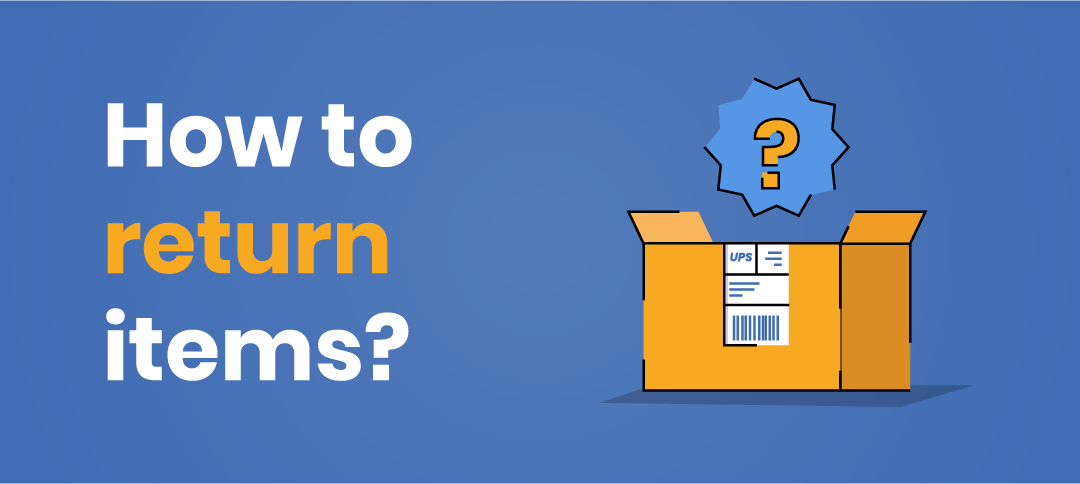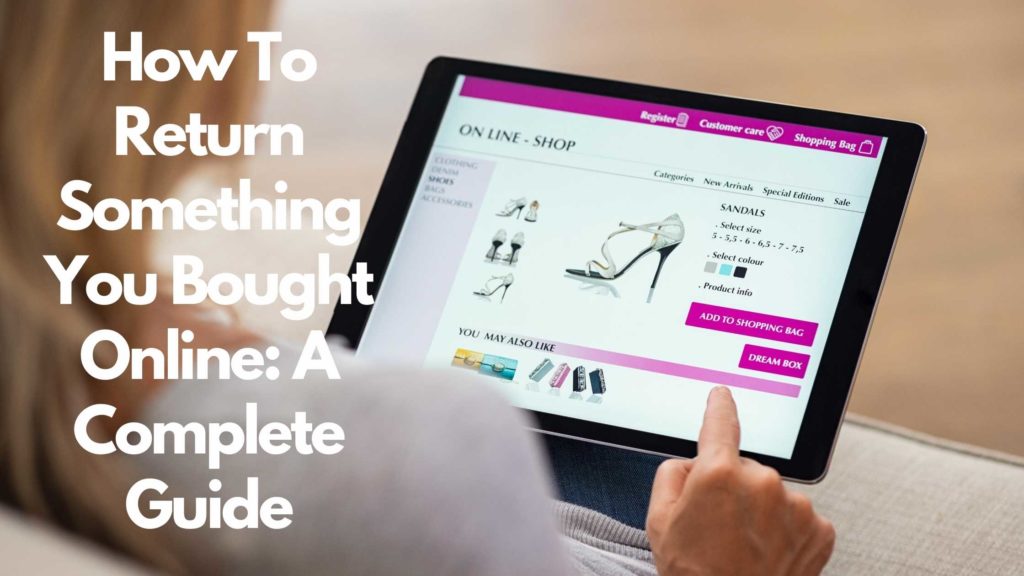how to return items bought online easily sets the stage for this enthralling narrative, offering readers a glimpse into a story that is rich in detail with casual formal language style and brimming with originality from the outset.
The process of returning items you purchased online can seem confusing, but with the right steps and a little know-how, you can make it much more manageable. By understanding retailer policies, knowing the typical reasons for returns, and following a clear procedure, you’ll find that sending back unwanted items is not only straightforward but can also help you shop with greater confidence in the future.
Understanding the Online Return Process
Returning items bought online is a routine part of modern shopping. Understanding the typical process and requirements can make your experience smoother and help you avoid common pitfalls. Most online retailers have established procedures, but the details can vary depending on the store and product.
General Steps Involved in Returning Online Purchases

The online return process generally consists of several key steps. Knowing what to expect at each stage can help prevent delays or misunderstandings about eligibility and refunds.
- Review the store’s return policy and eligibility guidelines before purchasing.
- Initiate the return via the retailer’s website or mobile app, following the Artikeld procedure.
- Prepare the item for return, ensuring it’s in the required condition and repackaged safely.
- Ship the item back using the method and shipping label provided, or arrange for a pickup.
- Track the return shipment and confirm its receipt with the retailer.
- Wait for the refund, replacement, or store credit as per the retailer’s policy.
Importance of Reading Return Policies Before Purchasing
Each retailer sets its own rules about which items can be returned, the acceptable timeframe, and the refund method. Some stores offer free returns, while others deduct shipping or restocking fees. Reviewing these policies before you buy helps prevent unwelcome surprises and ensures you know your rights as a customer.
Return Windows and Eligibility Differences Between Retailers
The timeframe for returns and eligibility requirements can differ widely. For instance, electronics often have shorter windows and stricter guidelines than clothing or home goods. Some retailers allow returns within 30 days, while others extend up to 90 days or more for select products. Always check details like unopened packaging, tags attached, or requirements for proof of purchase.
Common Reasons for Returning Online Purchases
Shoppers return online orders for a variety of reasons. Understanding these motivations can help both customers and retailers streamline the return process. The justification for a return can also vary depending on the product type, its value, and customer expectations.
Frequent Motivations for Returning Orders
While reasons for returns are diverse, several common themes emerge across product categories. The table below gives an overview of why customers send items back, alongside examples and how often they occur.
| Reason | Description | Example Item | Frequency |
|---|---|---|---|
| Wrong Size | Item doesn’t fit as expected | Shoes, clothing | High |
| Damaged on Arrival | Product arrives broken, scratched, or defective | Electronics, fragile goods | Medium |
| Not as Described | Item differs from photos or product details | Home decor, gadgets | Medium |
| Changed Mind | Customer no longer wants the item without defect | Books, accessories | Medium |
| Incorrect Item Shipped | Customer receives a different product than ordered | Kitchenware, electronics | Low |
| Late Delivery | Order arrives after an acceptable or promised date | Gifts, event-specific items | Low |
Variation in Return Justification by Product Type
Some products, such as shoes and apparel, are commonly returned due to sizing issues, while electronics are more likely to be returned for defects or technical problems. Home goods and decor might be sent back if they don’t match their online descriptions or images.
Steps to Initiate a Return Online
Starting a return online is usually straightforward when you follow the retailer’s process. Most stores guide you step by step, but having the right information ready can speed things up and help ensure your request is approved without delays.
Step-by-Step Procedure for Online Returns, How to return items bought online easily
Below is a detailed Artikel of each typical step to initiate an online return, including where to perform each action and what you’ll need at hand.
| Step Number | Action | Platform (Website/App) | Required Information |
|---|---|---|---|
| 1 | Log in to your account | Website / App | Email/username, password |
| 2 | Navigate to order history and select the item | Website / App | Order number, purchase date |
| 3 | Click “Return” or “Report Issue” | Website / App | Reason for return, item condition |
| 4 | Fill out the return request form | Website / App | Return reason, photos (if damaged), comments |
| 5 | Receive return authorization and instructions | Website / App, Email | Return label, packing instructions |
Accessing and Filling Out Return Request Forms
Most retailers require you to fill out a return request form online, specifying the reason for the return and providing supporting details. If the item is damaged or defective, uploading clear photos can help speed up the approval process. Always double-check your entries before submitting to avoid errors that could cause delays.
Packaging and Shipping Returned Items
Properly packaging your return ensures that the item arrives safely and in acceptable condition. Using the right materials and following the retailer’s shipping instructions are essential for a successful return and refund.
Best Practices for Packaging Return Shipments
Careful packaging protects items from damage during transit and improves your chances of a full refund. Aim to use the original packaging when possible, and reinforce it if it shows signs of wear.
- Use sturdy boxes or padded envelopes appropriate to the item’s size and fragility.
- Secure all accessories, manuals, and original tags in the package.
- Fill empty spaces with packing material to prevent movement.
- Seal the package tightly using strong tape.
- Attach the return label provided by the retailer in a visible spot.
Materials Needed for Secure Packaging
Gather the right supplies before starting your packing process to ensure everything is safely contained.
- Original packaging (if available)
- Sturdy cardboard box or padded envelope
- Bubble wrap or packing paper
- Strong packing tape
- Return shipping label
- Plastic bag for leak-prone items
Arranging Shipping Through Carriers
Retailers may offer several options for shipping your return, including prepaid shipping labels, carrier drop-off at a specified location, or scheduled pickups. Always follow the retailer’s instructions closely and keep any shipping receipts or tracking numbers until your refund or replacement is processed.
Tracking and Verifying the Return Process
After shipping your return, it’s crucial to track its journey and confirm that the retailer has received it. Staying informed reduces uncertainty and helps you anticipate when your refund or replacement will arrive.
Methods for Tracking Return Shipments
Most return services provide tracking numbers, allowing you to check the shipment’s status online. Some retailers also send notifications when your package is delivered and processed. The following table summarizes common tracking methods and key details to monitor.
| Tracking Method | Platform | Notification Received | Estimated Refund Time |
|---|---|---|---|
| Carrier Tracking Number | Carrier website/app | Package delivered | 5-10 business days |
| Retailer Order Status Page | Retailer website/app | Return received, refund initiated | 3-7 business days |
| Email or SMS Updates | Email/SMS | Return processed, refund issued | Varies by payment type |
Verifying Receipt of Returned Items
It’s essential to confirm that the retailer has received your return before expecting a refund. Check your account’s order status or contact customer service if you don’t see updates within a few days of delivery. Retain all tracking numbers and shipping receipts until your return is fully resolved.
Receiving Refunds or Replacements
Once your return is processed, you’ll receive a refund, replacement, or store credit depending on the retailer’s policy and your preference. The timeline and method for reimbursement can vary significantly based on payment type and the store’s procedures.
Differences Between Refunds, Exchanges, and Store Credit
Retailers may handle returns in several ways. You might be offered a direct refund to your original payment method, an exchange for another item, or store credit for future purchases. Some stores allow you to choose, while others have fixed policies based on product type or reason for return.
Variation in Refund Timelines and Methods
Refund processing times can differ depending on your original payment method. Credit and debit card refunds typically take 3-7 business days after approval, while store credits or gift card refunds are often immediate. PayPal and other digital wallets may process refunds within a day or two, but bank transfers could take up to a week.
For the quickest refund or replacement, provide complete information, return unused items in their original packaging, and respond promptly to any retailer requests. Keep all documentation until the process is finalized.
Tips for Hassle-Free Returns
A smooth return process starts with a clear understanding of requirements and good documentation. By taking certain proactive steps, you can avoid common issues and ensure your refund or exchange is processed swiftly.
Actionable Strategies for Easy Returns

Consider these tips to help simplify every return and reduce the chances of complications:
- Save all receipts, order confirmations, and emails until your return is complete.
- Take photos of the item and packaging before shipping, especially for damaged or defective products.
- Follow the retailer’s return instructions closely and meet all deadlines.
- Use the retailer’s preferred shipping method and keep tracking information.
- Communicate promptly with customer service if issues arise.
Illustrative Return Scenarios and Lessons Learned
Real-life examples highlight the value of following procedures and good communication:
- Apparel Return: Jane ordered shoes that didn’t fit. She saved the original box, followed the store’s online return steps, and received a refund within five days.
- Defective Electronics: Mike’s headphones stopped working. He photographed the defect and submitted the images with his return request. His swift response to customer service inquiries led to a prompt replacement.
- Uncooperative Retailer: Alex tried to return a blender missing its packaging. The retailer initially refused, but Alex provided email proof of purchase and photos, resulting in store credit after further discussion.
Effective Documentation and Communication Practices
Having a clear paper trail and communicating politely but firmly with retailers can help resolve disputes. Always document every interaction, note names and dates, and summarize conversations in follow-up emails when needed.
Understanding Exceptions and Non-Returnable Items: How To Return Items Bought Online Easily
Not all products are eligible for returns. Understanding which items are commonly non-returnable and why can help you make informed purchasing decisions and know your options if issues arise.
Common Non-Returnable Items and Exceptions
The following table Artikels product categories that are often non-returnable, along with typical reasons and policy alternatives:
| Item Type | Reason for Exception | Retailer Policy | Alternatives |
|---|---|---|---|
| Personal care products | Health & safety regulations | All sales final | Contact customer service for defects |
| Perishable goods | Spoilage risk | Non-returnable | Replacement for damaged goods |
| Customized or personalized items | Cannot be resold | No returns unless faulty | Partial refunds for errors |
| Digital downloads | Instant access | All sales final | Redownload or support for issues |
| Opened software or media | Copyright regulations | No returns if seal broken | Exchange for defective discs |
Options for Handling Non-Returnable Merchandise
If you encounter a problem with a non-returnable item, contact customer service to discuss possible solutions. Retailers may offer partial refunds, replacements, or technical support depending on the situation. Document your case with photos, receipts, and communication logs to support your claim.
Utilizing Customer Service Support for Returns
Customer service teams are an invaluable resource when return situations become complicated. Knowing how and when to reach out ensures you get the assistance you need and helps resolve issues efficiently.
When and How to Contact Customer Service
If you face delays, unclear policies, or disputes about eligibility, it’s best to contact customer service directly. Most retailers offer support via phone, live chat, or email. Choose the channel that’s most convenient for you, and be prepared to explain your situation clearly.
Essential Information to Have Ready
Having key details at hand can help customer service representatives assist you more effectively:
- Order number and item details
- Reason for return and steps already taken
- Photos or documentation if applicable
- Dates of purchase, delivery, and attempted return
Effective Communication Strategies for Return Issues

Polite, concise communication ensures your case is taken seriously. Summarize the issue, provide supporting evidence, and state the resolution you seek. If escalation is needed, ask to speak to a supervisor and document all correspondence for your records.
Final Conclusion
Mastering how to return items bought online easily can transform your overall shopping experience, turning a potentially stressful task into a quick and efficient process. By staying attentive to policies, keeping communication clear, and preparing ahead of time, you ensure every return goes off without a hitch, letting you shop online with greater peace of mind.
Frequently Asked Questions
Do I need the original packaging to return an item?
While many retailers prefer returns in original packaging, some will accept items without it. Always check the store’s return policy for specific requirements.
How long do I have to return an item bought online?
Return periods vary by retailer, typically ranging from 14 to 30 days after delivery. Some stores may offer extended windows during holidays or for certain products.
Can I return an online purchase in a physical store?
This depends on the retailer. Many large brands allow in-store returns for online purchases, but always confirm store policy before visiting.
What should I do if my return is rejected?
If your return is denied, contact customer service to understand the reason and ask about alternative solutions, such as exchanges or store credit.
Will I be refunded for shipping costs?
Some retailers refund shipping charges, but many do not. Carefully review the return policy or reach out to support for clarification.